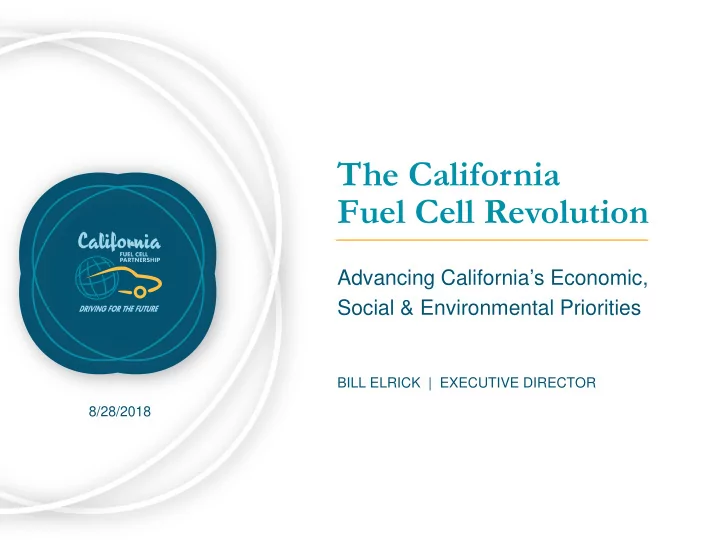

The California Fuel Cell Revolution Advancing California’s Economic, Social & Environmental Priorities BILL ELRICK | EXECUTIVE DIRECTOR 8/28/2018
How it all began – 2012 C Cal alifornia a Road admap ap First 100 stations statewide • Establish initial network coverage • Clusters in big cities • “Connectors” and “destination” . stations across the state • Vision for starting commercial rollout 2
Where we are today INNOVATORS Tech Adventurous Vehicle Cost Higher than gasoline cars Development NASCENT MARKET Vehicle Performance Numbers as of July 2018 fuel cell cars Close to gasoline cars 4,926 fuel cell cars Vehicle Emissions First Better than gasoline cars 35 retail hydrogen stations H2 stations Vehicle Range 24 fuel cell buses Close to gasoline cars Sparse Fuel Cost H2 network Higher than gasoline H2 Network Coverage Customer adapts Worse than gasoline to technology TODAY 3
— MISSION — Accelerate commercialization of hydrogen and fuel cell vehicles 4
What is the revolution? 5
Evolution of customer adoption INNOVATORS EARLY ADOPTERS Tech Adventurous Visionary Development Retail CRITICAL MASS fuel cell cars fuel cell cars Early Retail H2 H2 stations stations Sparse H2 network Customer adapts Transition to to technology mainstream 2012 -today Through 2030 6
— CaFCP Goal — Enable market conditions to support: 1,000 hydrogen stations and 1,000,000 fuel cell vehicles by 2030 7
Matching the coverage of gas stations ≈ 8,000 1,000 retail gas stations retail H2 stations 8
How do we get there? 9
Enable the market by attracting capital investment in infrastructure 10
Enable large-scale infrastructure Focus on risk management and cost offsets Transition from grant funding to market- based policies that encourage private Market investment policies Economies of scale Private investment Customer adoption increases increases Costs decline Renewable H 2 production increases 11
Market-based policies build confidence Market-based policies build confidence Hydrogen Electric charging Energy Commission $150 Energy Commission $265 Electrify America $184 Public Utilities Commission $738 In millions 12
Establish the market with a competitive value proposition to increase consumer demand 13
Build a strong customer base Incentives spur vehicle sales to customers in across the economic spectrum Customer incentives Hydrogen The H2 station network enables travel network throughout California and beyond Market Dedicated policies supply Hydrogen production and distribution stay Economies ahead of fuel demand of scale Private investment Consumer customer increases base Costs decline Renewable H 2 production increases 14
Scaling for success 1,000,000 California Vehicle Population 800,000 600,000 400,000 200,000 0 0 5 10 15 Years After Market Introduction HEV BEV PHEV FCEV BEV Proj. PHEV Proj. FCEV Vision
Expand the fuel cell and hydrogen market across the transportation and energy spectrum 16
Expand the use of hydrogen and fuel cells Empower fuel cell trucks Customer incentives and hydrogen stations along freight corridors Hydrogen network Trucks Market Broaden the portfolio of Dedicated policies Diversify hydrogen and fuel cell supply applications Grid Economies integration of scale Connect hydrogen, electricity, and renewables Private investment Broad customer increases base Costs decline Renewable H 2 production increases 17
The energy system • Grid balancing • Demand management • Energy storage • Meeting renewable targets 18
— OUTCOMES — Economic, Social, & Environmental Benefits 19
— ECONOMY — Establish a self-sustaining market Desirable products and services that make economic sense for customers and businesses 20
— SOCIETY — 97% of DACs and 94% of Californians within the station network coverage 21
— ENVIRONMENT — 693.5 million gallons of gas displaced 2.7 million metric tons of GHG avoided 3,900 metric tons of NOx avoided 22
How are we starting the revolution? 23
CaFCP Members 2 4
— Delivering Positive Change — Addressing cost challenges Renewable hydrogen pathways Expanding beyond California Sustainable freight
Customer Incentives Hydrogen Network Trucks Market Dedicated Policies Diversify Supply Grid Economies MISSION OUTCOMES Integration of Scale Accelerate Economic, Social, and commercialization SELF- Environmental of hydrogen and SUSTAINING Benefits fuel cell vehicles Private Growing MARKET investment market Costs parity Renewable H 2 26
Self-sustaining INNOVATORS EARLY ADOPTERS EARLY MAJORITY Tech Adventurous Visionary Pragmatic VALUE PROPOSITION SELF-SUSTAINING MARKET Vehicle Cost Same as gasoline cars Development Retail fuel cell cars fuel cell cars Vehicle Performance Better than gasoline cars Early Retail H2 Vehicle Range H2 stations stations Same as gasoline cars Fuel Cost Sparse Statewide H2 network Less than gasoline H2 Network H2 Network Coverage Customer adapts Transition to Traditional customer Same as gasoline to technology mainstream interactions 27
We’re creating transformative change for a brighter, healthier future. Join the revolution. 28
Recommend
More recommend